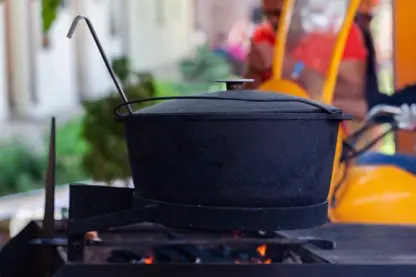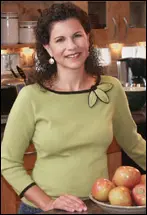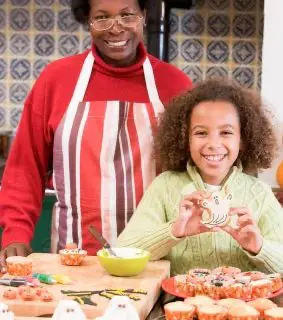The Whole Story on Whole Foods: Why they’re important for a healthy body
By Elizabeth Yarnell
No, not the grocery store
Less
than a century ago, our diet was made up entirely of
whole foods. Nowadays, many people in our society wouldn’t
know how to prepare
a whole food for eating if they were stuck on an episode of Survivor.
Yet
to have a healthful and nutritionally-sound diet,
highly-processed foods should make up less than 20% of our daily feed.
But what
exactly does the term “whole foods” mean, and why
are they so important to a
healthy body?
The
term “whole foods” has been thrown around so
loosely
that many people confuse it with “organic.”
Make no mistake: these do not mean the same thing.
Organic
refers to foods or ingredients grown in a
chemical-free environment, without the use of artificial pesticides,
fertilizers or hormones.
Whole food is food that has only one
ingredient: itself in
its natural form. In other words, a food that hasn’t been
processed into
another state.
Organic
foods can be processed and still be called organic
if they are made with organic ingredients. For instance, you can have a
package
of organic cookies in which the cookies have been made with all organic
ingredients, but this is still considered a processed food because the
ingredients have been altered from their original state. The wheat has
been
ground, the sugar has been extracted from the cane… etc.
While it is certainly an admirable goal to eat
organic, we
should strive to include whole foods in our daily diet as well.
Why are whole foods
so important?
Our
bodies — our systems for digestion, absorption, and
metabolism – evolved to utilize nutrients in the amounts and
combinations
provided by the food that grows naturally on this planet. Foods are
made up of
hundreds of different, health-giving substances that work together synchronistically to deliver health. The
only way to take advantage of this packaging is by eating the whole
food itself
rather than a product that is a derivative of it.
Many
biochemical researchers, nutritionists and herbalists
believe that the body will never achieve maximum nutrition and an
ultimate
healthy state without whole foods. Vitamin supplements do not replace
the
nutritional value of whole foods because vitamins only resemble
selected parts
of a food. They do not contain the complex, interwoven structure of
nutrients
and other substances found in one bite of whole food. Additionally,
whole foods
are alive with enzyme activity while isolated vitamins are not living
substances. And even so-called “natural” vitamins
are often more than 90%
synthetic.
Here’s
an example of the different effect of vitamins versus
whole foods: The medical community has long known that a diet full of
plant-based
foods that are rich in beta-carotene can help protect against cancer.
But a
recent large-scale study that administered beta carotene supplements to
lung
cancer patients actually proved harmful. It seems that beta carotene is
only
one of the many substances contained in the whole foods that was
providing the
protection against cancer. They actually had to stop the study early
because it
was causing so much harm.
The
safest bet for getting the full benefit out of nutrients
and other substances in plants is to consume them in their original
packaging
as designed by Mother Nature.
The
opposite of whole foods are processed foods. The more
steps away from the original plant, the more processed the food is and
the
fewer nutrients remain. Processing increases our ability to store food
for
later use, allowing communities to live farther away from the source of
the
food.
Let’s
look at the transformation of the whole food of a
potato into a highly processed potato chip: First, the potato is
peeled, losing
fiber, iron and calcium along with the skin. Then it is washed, rinsing
away
carbohydrates, vitamin C and minerals. It’s sliced, washed
again, and fried,
removing water and destroying B vitamins while adding fat. Then it is
salted,
flavored with spices and given artificial colorings, and finally it is
preserved with chemical preservatives.
The
result of all this processing?
Shelf-life, crunch and
convenience, along with 70 times the fat, 20 times the salt, 1/2 the
carbohydrates, and less than 1/3 the fiber, iron, vitamin C and thiamin
of a
baked potato.
And
we haven’t even begun to look at partitioning, which is
when some part of the food is taken or separated from the rest, such as
sugar
from beets, oil from peanuts, or refined flour from whole grains.
Nearly 70% of
the US
food supply consists of partitioned foods that are almost completely
devoid of
fiber, vitamins and minerals.
Adding
whole foods to your diet enables you to enjoy all the nutrition offered
by nature’s bounty, leading to better health and better
eating habits. Here is
a recipe that uses only whole foods to make a flavorful, satisfying and
nutritious meal.
Cajun Fish

Servings: 2
Ingredients1 potato:
russet or sweet or 1/2 of each
1/4
onion, peeled and sliced thinly
10-15
green or string beans, washed & trimmed
1/2-3/4
lb. white fish (catfish, sole, cod, halibut...)
Creole
or Cajun seasoning
3-5
whole garlic cloves, peeled
4
small Roma tomatoes, washed & quartered
Instructions<
Preheat
oven to 450 degrees. Spray inside of a 2-quart cast iron Dutch oven and
lid
with olive oil or canola oil spray.
Scrub
potato well and cut out any bad spots or eyes. Cube potato into 1"
cubes.
Halve beans or leave whole, as desired.
Line
base of pot with onions. Rinse fish and pat dry with paper towels. Lay
the fish
over the onions in the bottom of the pot. Sprinkle the top side
liberally with
Cajun seasoning mix according to taste, and then sprinkle with garlic.
Make a
layer of potatoes and then one of green beans, interspersing sprinkles
of
spices as desired. Tuck the tomatoes around the top.
Cover
and bake for about 40 minutes, or until fish flakes easily and potatoes
are
fork-tender. You should smell the aroma wafting from the oven that
tells you
everything is done.
Tips:
We
love Tony Chachere's Famous Creole Seasoning, but any Cajun or Creole
seasoning
mix from the grocery will do, or mix together equal parts paprika,
salt, and a
dash of cayenne to make your own. Careful with the cayenne as a little
goes a
long way and you may find that this unique cooking method intensifies
spices.
This
cooking technique will accept any frozen elements without any change in
cooking
time or flavor. Feel free to substitute frozen green beans and frozen
fish
filets straight from the freezer.
Don't
feel like having fish? Just substitute the fish layer for chicken
pieces,
turkey tenderloin or pork tenderloin.


Elizabeth Yarnell is the author of www.GloriousOnePotMeals.com. The Glorious One-Pot Meal cooking method. More about Elizabeth Yarnell
More from Elizabeth Yarnell:
French Riviera Tomato Trout with Potatoes and how food can help prevent disease.
| 




